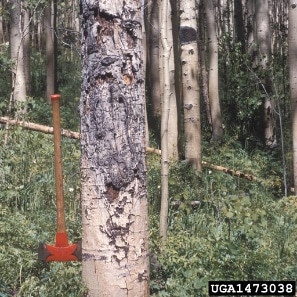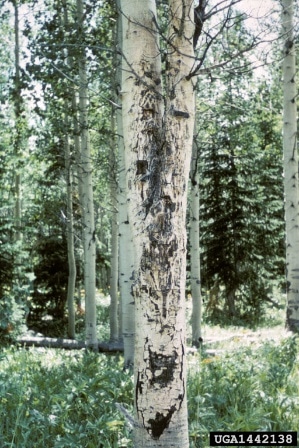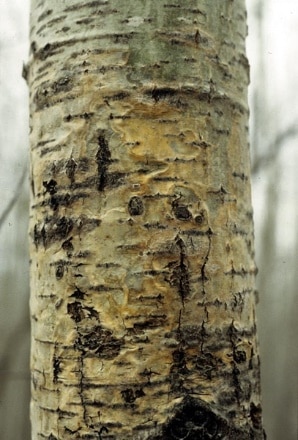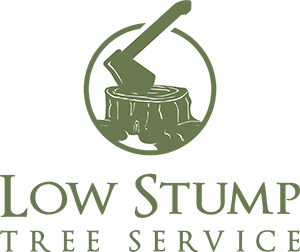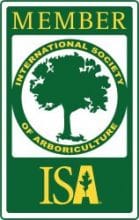Fungi: Hypoxylon mammatum
SIGNS / SYMPTOMS:
Young cankers appear as distinctive “yellowish-orange” areas of branch and trunk sections. “appearing as if Crayon was rubbed over the bark.” As infection progresses (over years) trunk sections will become blistered and raised or swollen, progression continues with patches sloughing off, exposing a blackened and crumbling interior. Can form around serveral separate location on tree. Generally, infections can be found on weakened trees and infection sights will be around damaged areas of tree, and can be a good determinate for root damage.
LIFE CYCLE:
Although much research has been done in the study of the reproduction of the Hypoxylon the direct cause of how it affects aspen is unknown. New Research points to Gall insects and Ciciada, being the transport. Both Young Growth, and Old Established Aspens are susceptible to infection, the determinate factor is the specific clone. The disease does most damage to younger trees, as they often infected lower on the trunk where the cankers can be lethal; whereas infection on the upper canopy can often be replaced by and subordinate lead.
MANAGEMENT:
Best Management is to reduce and eliminate possibility and conditions for infestation. Various levels of Integrated Pest Management must be considered. Effective Chemical control is NOT available.
Cultural Control Method: Removal on any and all infected material. This must be carefully considered by and Arborist or Tree professional, as removal of ALL material is often not practical or responsible to the ecosystem. Value of Landscape trees must also be carefully considered. General goal should be toward removal of infected material where possible, pair with a vigorous promotion of healthy growth in replacement trees.
Mechanical/Physical Control Method: Removal of any “Yellowish-orange” branches or small young trees. As these areas of infection show early development, the removal of these areas will reduce future reproduction. When infected area is in the upper grown or “top” special consideration must be taken to negate any secondary / lethal damage to tree long term. Whole trees should be removed from stand to promote growth of healthy no-infected replacements.
Environmental Control Method: Hypoxylon Canker infects stressed trees. The environmental control is the process of reducing that stress. Firstly, removing and infected tree material where possible. Then testing and possible amendments to soil. Proper establishment of proper tree ring is highly recommended. Removal of any girdling. Application of Chelated Iron (Fe) as most all trees of the genus are iron deficient in our soil scape.
Chemical Control Method: Direct chemical control of the fugus is NOT available. Application of Chelated Iron (Fe) applied to root zone will help areas of chlorosis conditions. Use of Cambistat Growth Regulator to increase the production of Abscisic Acid. (root growth, and stoma strength). Cambistat application is highly recommended for any “High Value” Landscape trees, as most landscape trees are inevitably in a stressed condition.
TREATMENT:
Cambistat:
Apply every 3 years. $10/inch trunk diameter
Chelated Iron:
Apply Anytime during growing season; $55/Bag (treats 100sqft of root zone)
Professional Pruning
Call for Estimate.

